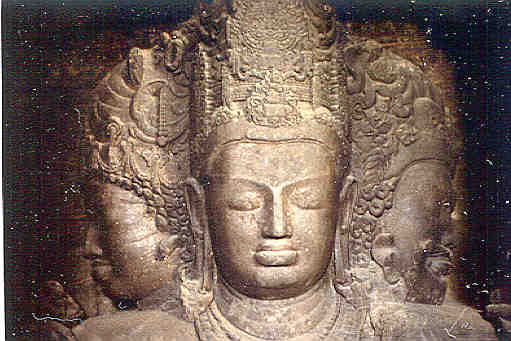The Elephanta Caves are a great tourist
attraction in the vicinity of the large Mumbai meteropolis. The Elephanta
island is located 10 km away from the Gateway of India at Mumbai. These caves house rock
cut temples dating back to the 5th century CE.

The Elephanta island was so named by the Portuguese,
after the statue of an elephant near the landing area of the island. These rock cut
temples dedicated to Shiva Mahadeva are rich in sculptural content.
Motorboats take passengers from Appollo Bunder near the Gateway of India. .
How They were Constructed: This rock
cut temples were created by carving out rock, and creating the columns, the internal
spaces and the images. The entire temple is akin to a huge sculpture, through whose
corridors and chambers one can walk. The entire complex was created through a process of
rock removal. Some of the rock surfaces are highly finished while some are untreated bare
rock.
The entire cave temple complex covers
an area of about 60000 squrare feet and it consists a main chamber and two lateral
ones , courtyards and several subsidary shrines. Above the temple is the mass of natural
rock.
There are three entrances to this temple. The ones on
the east and the west marking the axis of the temple. A 20 pillared hall lines the axis,
and on its western end is the cella in shich is enshrined a Shivalingam.
The pillars consist of fluted columns standing on square bases, and are crowned with
fluted cushion capitals.
The enigmatic image of Trimurthi Sadasiva:
The Sadasiva manifestation of Shiva is carved in relief at the end of the north south
axis. This collossal 20 feet high image of the three headed Shiva, Trimurthy
is a magnificient one, considered to be a masterpiece of Indian art. This colossal
image represents Panchamukha Shiva, only three faces of
whom are carved into the wall and it demands immediate attention upon entering the temple
through the northern entrance. See All About Shiva
for more information on Panchamukha Shiva.
Also on the southern wall are grand sculptured images
of Kalyanasundara, Gangadhara, Ardhanariswara and Uma Maheswara. To the
west of the northern entrance are sculptured images of Nataraja and Andhakaasuravadamoorthy,
and to its east are images of Yogiswara and Ravanaanugrahamurthy.
Thus in the Elephanta caves, Shiva is portrayed in the
non anthropomorphic Shivalingam form, as well as in his quintessential
being emanating from the Shivalingam in the colossal image, and in 8 manifest forms.
To the east of the main temple is a courtyard, flanked
by the secondary shrine. This temple contains six pillars at its entrance, four of which
are free standing and two engaged. The entrance leads to a hall decorated with sculptured
panels depicting legends from the Shiva Purana.
See Also:
All About Shiva
Significance of the Shivalingam
Iconic representations of Shiva
Andakaasura Samhaaram
Kailasanatha Rock Cut Temple at Ellora
